
An altar is a table or platform for the presentation of religious offerings, for sacrifices, or for other ritualistic purposes. Altars are found at shrines, temples, churches, and other places of worship. They are used particularly in paganism, Christianity, Buddhism, Hinduism, Judaism, modern paganism, and in certain Islamic communities around Caucasia and Asia Minor. Many historical-medieval faiths also made use of them, including the Roman, Greek, and Norse religions.

In Eastern Christianity, an iconostasis is a wall of icons and religious paintings, separating the nave from the sanctuary in a church. Iconostasis also refers to a portable icon stand that can be placed anywhere within a church. The iconostasis evolved from the Byzantine templon, a process complete by the 15th century.
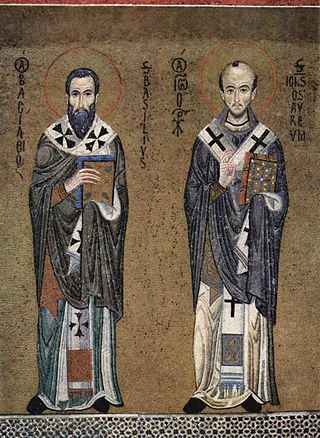
Divine Liturgy or Holy Liturgy is the usual name used in most Eastern Christian rites for the Eucharistic service.

Holy Week is the most sacred week in the liturgical year in Christianity. For all Christian traditions, it is a moveable observance. In Eastern Christianity, which also calls it Great Week, it is the week following Great Lent and Lazarus Saturday, starting on the evening of Palm Sunday and concluding on the evening of Great Saturday. In Western Christianity, Holy Week is the sixth and last week of Lent, beginning with Palm Sunday and concluding on Holy Saturday.
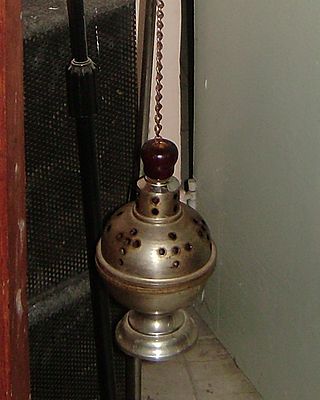
A thurible is a metal censer suspended from chains, in which incense is burned during worship services. It is used in Christian churches, including the Roman Catholic, Eastern Orthodox, Assyrian Church of the East and Oriental Orthodox, as well as in some Lutheran, Old Catholic, United Methodist, Reformed, Presbyterian Church USA, and Anglican churches. In Roman Catholic, Lutheran, and Anglican churches, the altar server who carries the thurible is called the thurifer. The practice is rooted in the earlier traditions of Judaism dating from the time of the Second Jewish Temple.

The Paschal Triduum or Easter Triduum, Holy Triduum, or the Three Days, is the period of three days that begins with the liturgy on the evening of Maundy Thursday, reaches its high point in the Easter Vigil, and closes with evening prayer on Easter Sunday. It is a moveable observance recalling the Passion, Crucifixion, Death, burial, and Resurrection of Jesus, as portrayed in the canonical Gospels.
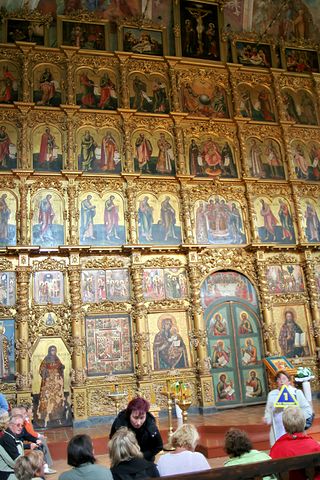
The Byzantine Rite, also known as the Greek Rite or the Rite of Constantinople, is a liturgical rite that is identified with the wide range of cultural, devotional, and canonical practices that developed in the Eastern Christian church of Constantinople.

The sticharion is a liturgical vestment of the Eastern Orthodox and Eastern Catholic Churches, roughly analogous in function to the alb of the Western Church. The sticharion is worn by all classes of ordained ministers in the Constantinopolitan Rite and comes in two forms: one worn by priests and one worn by deacons and other altar servers.

In the Christian liturgical calendar, there are several different Feasts of the Cross, all of which commemorate the cross used in the crucifixion of Jesus. Unlike Good Friday, which is dedicated to the passion of Christ and the crucifixion, these feast days celebrate the cross itself, as the sign of salvation. In Western Catholicism, Eastern Catholicism, Eastern Orthodoxy, Oriental Orthodoxy, Lutheranism and Anglicanism the most common day of commemoration is 14 September, or 27 September in churches still using the Julian calendar.

The Easter Vigil, also called the Paschal Vigil or the Great Vigil of Easter, is a liturgy held in traditional Christian churches as the first official celebration of the Resurrection of Jesus. Historically, it is during this liturgy that people are baptized and that adult catechumens are received into full communion with the Church. It is held in the hours of darkness between sunset on Holy Saturday and sunrise on Easter Day – most commonly in the evening of Holy Saturday or midnight – and is the first celebration of Easter, days traditionally being considered to begin at sunset.

The Armenian Rite is a liturgical rite used by both the Armenian Apostolic and the Armenian Catholic churches. Isaac of Armenia, the Catholicos of All Armenians, initiated a series of reforms with help from Mesrop Mashtots in the 5th century that distinguished Armenia from its Greek and Syriac. These reforms included a retranslation of the Bible and a revised liturgy. During the Crusades and afterwards, missionary activity by the Latin Church influenced liturgical norms and induced some Armenians to join the Catholic Church. The modern Armenian Rite features elements and interpolations from the Byzantine Rite and Latin liturgical rites, with the celebration of the Eucharist emulating the Liturgy of Saint Basil.
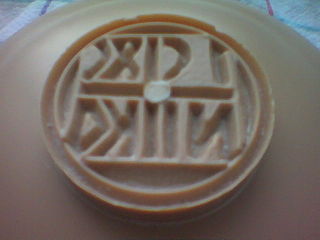
A prosphoron is a small loaf of leavened bread used in Orthodox Christian and Greek Catholic (Byzantine) liturgies. The plural form is prosphora (πρόσφορα). The term originally meant any offering made to a temple, but in Orthodox Christianity and Byzantine Rite Catholicism it has come to mean specifically the bread offered at the Eucharist during Divine Liturgy.
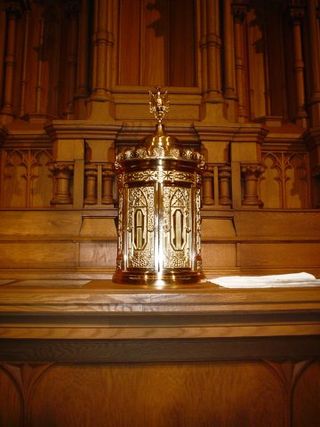
A tabernacle or a sacrament house is a fixed, locked box in which the Eucharist is stored as part of the "reserved sacrament" rite. A container for the same purpose, which is set directly into a wall, is called an aumbry.

A paten or diskos is a small plate, used during the Mass. It is generally used during the liturgy itself, while the reserved sacrament are stored in the tabernacle in a ciborium.

The royal doors, holy doors, or beautiful gates are the central doors of the iconostasis in an Eastern Orthodox or Eastern Catholic church. The sanctuary is separated from the nave by a wooden screen called the iconostasis. The iconostasis represents Christian continuity from the veil of the Temple in Jerusalem which separated the people from the Holy of Holies that housed the Ark of the Covenant. Normally, the iconostasis has three doors in it. The two single doors to the right and left are called "deacons' doors" or "angel doors" and they usually have on them icons of either sainted deacons or the Archangels Michael and Gabriel. These are the doors that the clergy will normally use when entering the sanctuary. The central double doors are the "holy doors", which are considered to be most sacred, and may only be entered at certain sacred moments during the services, and only by ordained clergy.

Eastern Orthodox church architecture constitutes a distinct, recognizable family of styles among church architectures. These styles share a cluster of fundamental similarities, having been influenced by the common legacy of Byzantine architecture from the Eastern Roman Empire. Some of the styles have become associated with the particular traditions of one specific autocephalous Eastern Orthodox patriarchate, whereas others are more widely used within the Eastern Orthodox Church.
Eastern Orthodox worship in this article is distinguished from Eastern Orthodox prayer in that 'worship' refers to the activity of the Christian Church as a body offering up prayers to God while 'prayer' refers to the individual devotional traditions of the Orthodox.
Western Rite Orthodoxy, also called Western Orthodoxy or the Orthodox Western Rite, are congregations within the Eastern Orthodox tradition which perform their liturgy in Western forms.

A processional cross is a crucifix or cross which is carried in Christian processions. Such crosses have a long history: the Gregorian mission of Saint Augustine of Canterbury to England carried one before them "like a standard", according to Bede. Other sources suggest that all churches were expected to possess one. They became detachable from their staffs, so that the earliest altar crosses were processional crosses placed on a stand at the end of the procession. In large churches the "crux gemmata", or richly jewelled cross in precious metal, was the preferred style. Notable early examples include the Cross of Justin II, Cross of Lothair, and Cross of Cong.

A blessing cross is a hand cross held by a priest or bishop in Eastern Christianity when he gives a benediction. It is often made of precious metal and may be adorned with enamelwork, and precious or semi-precious gemstones. The cross may also have other icons on it, such as the Theotokos, John the Baptist, the Four Evangelists or Prophets.


















